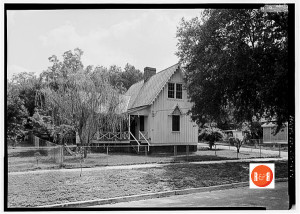
Information from: The Library of Congress – HABS Photo Collection (23 Gregg St., Graniteville, S.C.)
The Rock Hill Herald reported on May 5, 1881 – “The Graniteville and Vaucluse Factories cleared a profit of $90,000. last year, which is 15% of their capital.”
The Yorkville Enquirer reported on the Graniteville Manufacturing Warehouse of Feb. 6, 1889 reported – “A fire at Graniteville destroyed the warehouse of the manufacturing company and they lost 2,346 bales of cotton.”
City Directories and History: See the link to William Gregg, S.C. early textile industrialist, who lived for much of his life in Charleston. Be sure to open the two History Threads, below, for further information and connections to the history of Graniteville, S.C.
Graniteville in 1849 was described as having mill buildings of hammered blue granite, 8,400 spindles, 300 looms, 150 acres of ground, two churches, the Academy, a hotel, 10 stores and 83 cottages. There was a company doctor and a clinic with very modest charges. Alcohol was absolutely forbidden in the village. – Pettus
As 1853 was coming to an end, John Springs III (born December 24, 1782) died. A man of experience and sagacity, Springs was the wealthiest man in the Up Country of South Carolina, and also one of the wealthiest men in the entire State. He was a legislator, a planter, a financier, a banker, an entrepreneur, a founder of the famous Graniteville Mill, and a premier railroad advocate in the South. It was his influence that helped to create the Charlotte and South Carolina Railroad Company, in which he was one of the biggest stockholders. One of the steam engine of that rail line was called “The John Springs.” His death on November 21, 1853, removed from the scene York District’s richest and most progressive citizen. He was a man of vision. He always looked to the future. His well-reasoned advice was to be sorely missed in the leadership circles of York District and South Carolina. (Along the Landsford Road, by Wm. B. White, Jr. Vol., I – 2008)
The Rock Hill Herald reported on April 29, 1880 – “A.E. Hutchison recently attended the annual stock holders meeting of the Graniteville Manufacturing Company. Capt. Hutchison owns a large number of shares. The Pres. of the Company is Mr. Hickman. The Company has improved the factory, paid regular dividends, and the Vaucluse Factory has been built at a cost of $347,000., with 10,000 spindles.”
William Gregg (1800-1867) had already had a successful career as a jeweler by the time he became involved in the textile industry in the 1840s. After touring New England and seeing its textile mills and industrial towns, he began advocating that the states of the Southern United States should industrialize to compete economically with the north. Gregg obtained financing from Charleston financiers to establish a model textile business, which would (controversially for the slavery-dominated South) employ white laborers.[1][3]
Between 1845 and 1849 Gregg supervised the construction of a mile-long power canal, drawing water from Horse Creek and Bridge Creek, a mill building, schoolhouse, and 100 Carpenter Gothic wood frame worker housing units (of which 26 survive in good condition). He made available lots of land within the development for the construction of churches, of which two were eventually built. (One of these, St. John’s Methodist Church, is still standing.) The mill was furnished with the most recent technology for spinning and weaving, and went into operation in 1849. The financial success of the enterprise prompted the development of other, similar mills elsewhere in the South. Development was interrupted by the American Civil War, although this facility was one of the mainstays of textile production in the Confederacy. Gregg’s businesses continues to operate today, as Graniteville Specialty Fabrics.[1]

Early 20th century postcard view of Graniteville Mill and the monument to Wm. Gregg – Courtesy of the LP Collection, 2017
Graniteville is located west of Aiken, on the east side of Horse Creek, a tributary of the Savannah River to the south west. The historic district includes the original 1846 power canal (no longer used for that purpose), which runs north from the center of Graniteville on the west side of Canal Street (South Carolina Highway 191). It also includes the original 1849 mill building, the 1847 Graniteville Academy building, St. John’s Methodist Church, and the surviving line of 1840s worker houses on Gregg Street.
Information courtesy of Wikipedia – https://en.wikipedia.org/wiki/Graniteville_Historic_District_(South_Carolina)
Stay Connected
Explore history, houses, and stories across S.C. Your membership provides you with updates on regional topics, information on historic research, preservation, and monthly feature articles. But remember R&R wants to hear from you and assist in preserving your own family genealogy and memorabilia.
Visit the Southern Queries – Forum to receive assistance in answering questions, discuss genealogy, and enjoy exploring preservation topics with other members. Also listed are several history and genealogical researchers for hire.
User comments welcome — post at the bottom of this page.

R&R HISTORY LINK: Article from the SCHS Mag. “Early Labor Union Efforts in S.C. Cotton Mills” by M.A. McLaurin
Please enjoy this structure and all those listed in Roots and Recall. But remember each is private property. So view them
from a distance or from a public area such as the sidewalk or public road.
Do you have information to share and preserve? Family, school, church, or other older photos and stories are welcome. Send them digitally through the “Share Your Story” link, so they too might be posted on Roots and Recall.
Thanks!

